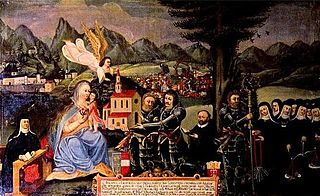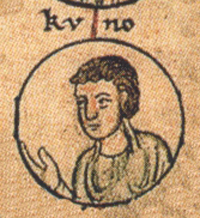
The Salian dynasty or Salic dynasty was a dynasty in the High Middle Ages. The dynasty provided four kings of Germany (1024–1125), all of whom went on to be crowned Holy Roman emperors (1027–1125).

The Duchy of Carinthia was a duchy located in southern Austria and parts of northern Slovenia. It was separated from the Duchy of Bavaria in 976, and was the first newly created Imperial State after the original German stem duchies.

Agnes of Poitou, a member of the Ramnulfid family, was the queen of Germany from 1043 and empress of the Holy Roman Empire from 1046 until 1056 as the wife of Emperor Henry III. From 1056 to 1061 she ruled the Holy Roman Empire as regent during the minority of their son Henry IV.

Conrad, a member of the Hohenstaufen dynasty, was the only son of Emperor Frederick II from his second marriage with Queen Isabella II of Jerusalem. He inherited the title of King of Jerusalem upon the death of his mother in childbed. Appointed Duke of Swabia in 1235, his father had him elected King of Germany and crowned King of Italy in 1237. After the emperor was deposed and died in 1250, he ruled as King of Sicily until his death.

Conrad I, called the Younger, was the king of East Francia from 911 to 918. He was the first king not of the Carolingian dynasty, the first to be elected by the nobility and the first to be anointed. He was chosen as the king by the rulers of the East Frankish stem duchies after the death of young king Louis the Child. Ethnically Frankish, prior to this election he had ruled the Duchy of Franconia from 906.

Ottokar I, also Otakar was count in the Bavarian Chiemgau and Margrave of Styria from 1056 until his death. He became progenitor of the dynasty of the Otakars.

Henry of Speyer, a member of the Salian dynasty, was count in the Rhenish Franconian Wormsgau. He was the father of Emperor Conrad II.
Henry of Eppenstein was Duke of Carinthia and Margrave of Verona from 1090 to 1122. He was the last duke from the House of Eppenstein.

Berthold II, Duke of Carinthia, also known as Berthold I of Zähringen, was a progenitor of the Swabian House of Zähringen. From 1061 until 1077, he was the Duke of Carinthia and Margrave of Verona.

Otto I, called Otto of Worms, a member of the Salian dynasty, was Duke of Carinthia from 978 to 985 and again from 1002 until his death.
Adalbero of Eppenstein was Duke of Carinthia and Margrave of Verona from 1011 or 1012 until 1035.
Burchard I, a member of the Hunfriding dynasty, was a Duke of Alamannia from 909 until his death. He also held the title of a margrave of Raetia Curiensis, as well as count in the Thurgau and Baar.

Conrad I, a member of the Salian dynasty, was Duke of Carinthia from 1004 until his death.
Conrad II, called the Younger, a member of the Salian dynasty, was Duke of Carinthia and Margrave of Verona from 1035 until his death.
The Ezzonids were a dynasty of Lotharingian stock dating back as far as the ninth century. They attained prominence only in the eleventh century, through marriage with the Ottonian dynasty of Holy Roman Emperors. Named after Ezzo, Count Palatine of Lotharingia from 1015 to 1034, they dominated the politics of the middle and lower Rhine and usually represented the royal interests. Under the Salian Emperors, they even briefly held the dukedoms of Swabia, Carinthia, and Bavaria.
Hezzelin I, Count in Zülpichgau, son of count palatine Hermann I of Lotharingia.
Henry I (d.1061), was Count Palatine of Lotharingia from 1045 until 1060. He was the son of Hezzelin I, Count in Zülpichgau, and a member of the Ezzonid dynasty. Historians have given several nicknames to Heinrich: Furiosus, because he murdered his wife, and Monachus, because he was confined into an abbey to treat his insanity.
Engelbert II, a member of the House of Sponheim, was Margrave of Istria and Carniola from about 1103/07 until 1124. In 1123, he succeeded his elder brother Henry as Duke of Carinthia and Margrave of Verona which he held until his retirement in 1135.

Henry III, called the Black or the Pious, was Holy Roman Emperor from 1046 until his death in 1056. A member of the Salian Dynasty, he was the eldest son of Emperor Conrad II of Germany and Gisela of Swabia.

Richardis of Sualafeldgau was Margravine of Austria from 976 until 994 as consort of the first Babenberg margrave Leopold I.











